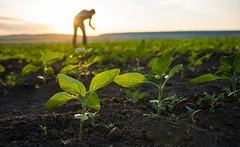Agriculture – Class 10 Geography
NCERT Chapter Summary | CBSE 2024–25 Board Ready
Introduction
Agriculture is the backbone of the Indian economy. Even today, it employs more than 50% of the country’s population and contributes significantly to the GDP. However, despite its importance, agriculture faces many challenges in India.Agriculture Class 10
In this chapter, we will explore different types of farming, major crops, the technological and institutional reforms in the sector, and the role agriculture plays in India’s economy.
Types of Farming in India
India’s diverse climate and topography support multiple types of farming:
1. Primitive Subsistence Farming
- Practiced in tribal and remote areas
- Uses traditional tools and family labor
- Slash and burn method (e.g., Jhumming in Northeast India)
2. Intensive Subsistence Farming
- Common in densely populated areas
- Uses small land holdings
- High labor input, mainly manual work
3. Commercial Farming
- Involves use of HYV seeds, fertilizers, and machinery
- Aimed at profit and surplus production
- Includes plantation crops like tea, coffee, rubber, sugarcane
Major Crops of India
India grows a wide variety of food and commercial crops. These are grouped into:
✅ Food Crops
a. Rice
- Staple food of eastern and southern India
- Requires high temperature and rainfall
- Grown in West Bengal, Punjab, Tamil Nadu, Uttar Pradesh
b. Wheat
- Main food crop in northern and north-western India
- Requires cool growing season and moderate rainfall
- Major producers: Punjab, Haryana, Uttar Pradesh, Madhya Pradesh
c. Millets (Jowar, Bajra, Ragi)
- Grown in dry, less fertile regions
- Rich in nutrients and climate-resilient
d. Pulses
- India is the largest producer and consumer
- Grow in dry conditions, fix nitrogen in soil
- Grown in Madhya Pradesh, Maharashtra, Uttar Pradesh
e. Maize
- Both food and fodder crop
- Requires moderate temperature and rainfall
✅ Commercial Crops
a. Sugarcane
- Tropical crop requiring hot, humid climate and irrigation
- India is the second-largest producer globally
b. Oilseeds
- Includes groundnut, mustard, soybean, sesame, sunflower
- Used for edible oils, soaps, and cosmetics
c. Tea and Coffee
- Plantation crops grown in hilly areas
- Tea: Assam, West Bengal, Kerala
- Coffee: Karnataka, Kerala, Tamil Nadu
d. Cotton and Jute
- Cotton: Black soil of Deccan Plateau (Maharashtra, Gujarat)
- Jute: Well-drained alluvial soil (West Bengal, Assam)
Technological and Institutional Reforms
After Independence, several measures were taken to improve agricultural productivity:
Technological Reforms
- Introduction of High-Yielding Varieties (HYV) seeds
- Use of chemical fertilizers and pesticides
- Farm mechanization (tractors, harvesters)
- Expansion of irrigation
Institutional Reforms
- Land reforms: abolition of zamindari, land ceiling
- Minimum Support Price (MSP) system
- Agricultural credit institutions (e.g., NABARD)
- Kisan Credit Card and crop insurance schemes
These reforms boosted productivity, especially during the Green Revolution.
Contribution of Agriculture to Indian Economy
- Provides employment to more than half of India’s workforce
- Supplies raw materials to industries (cotton, sugar, jute, etc.)
- Contributes to national income and export earnings
However, dependence on monsoons, small landholdings, and outdated methods still hamper progress.
Modern Challenges in Indian Agriculture
- Fragmented land holdings due to inheritance
- Overuse of chemicals leading to soil degradation
- Water scarcity in many regions
- Climate change affecting crop cycles
- Low income for farmers despite rising costs
Therefore, sustainable agriculture and innovation are urgently needed.
Summary Table
| Type of Farming | Features | Examples |
|---|---|---|
| Primitive Subsistence | Manual labor, low yield | Jhumming (NE India) |
| Intensive Subsistence | Small plots, labor-intensive | Rice in Bihar |
| Commercial Farming | Technology-based, high yield | Wheat in Punjab |
Practice Questions
Very Short Answer:
- Name two commercial crops of India.
- What is Jhumming?
Short Answer:
- What are the main features of Intensive Subsistence Farming?
- Write a short note on the Green Revolution.
Long Answer:
- Describe the major food crops grown in India with conditions.
- Explain technological and institutional reforms post-Independence.

